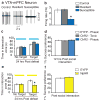Rapid regulation of depression-related behaviours by control of midbrain dopamine neurons
- PMID: 23235832
- PMCID: PMC3554860
- DOI: 10.1038/nature11713
Rapid regulation of depression-related behaviours by control of midbrain dopamine neurons
Abstract
Ventral tegmental area (VTA) dopamine neurons in the brain's reward circuit have a crucial role in mediating stress responses, including determining susceptibility versus resilience to social-stress-induced behavioural abnormalities. VTA dopamine neurons show two in vivo patterns of firing: low frequency tonic firing and high frequency phasic firing. Phasic firing of the neurons, which is well known to encode reward signals, is upregulated by repeated social-defeat stress, a highly validated mouse model of depression. Surprisingly, this pathophysiological effect is seen in susceptible mice only, with no apparent change in firing rate in resilient individuals. However, direct evidence--in real time--linking dopamine neuron phasic firing in promoting the susceptible (depression-like) phenotype is lacking. Here we took advantage of the temporal precision and cell-type and projection-pathway specificity of optogenetics to show that enhanced phasic firing of these neurons mediates susceptibility to social-defeat stress in freely behaving mice. We show that optogenetic induction of phasic, but not tonic, firing in VTA dopamine neurons of mice undergoing a subthreshold social-defeat paradigm rapidly induced a susceptible phenotype as measured by social avoidance and decreased sucrose preference. Optogenetic phasic stimulation of these neurons also quickly induced a susceptible phenotype in previously resilient mice that had been subjected to repeated social-defeat stress. Furthermore, we show differences in projection-pathway specificity in promoting stress susceptibility: phasic activation of VTA neurons projecting to the nucleus accumbens (NAc), but not to the medial prefrontal cortex (mPFC), induced susceptibility to social-defeat stress. Conversely, optogenetic inhibition of the VTA-NAc projection induced resilience, whereas inhibition of the VTA-mPFC projection promoted susceptibility. Overall, these studies reveal novel firing-pattern- and neural-circuit-specific mechanisms of depression.
Figures




References
-
- Willner P, Hale AS, Argyropoulos S. Dopaminergic mechanism of antidepressant action in depressed patients. J Affect Disord. 2005;86:37–45. - PubMed
-
- Nestler EJ, Carlezon WA., Jr The mesolimbic dopamine reward circuit in depression. Biol Psychiatry. 2006;59:1151–1159. - PubMed
-
- Berton O, Nestler EJ. New approaches to antidepressant drug discovery: beyond monoamines. Nat Rev Neurosci. 2006;7:137–151. - PubMed
-
- Yadid G, Friedman A. Dynamics of the dopaminergic system as a key component to the understanding of depression. Prog Brain Res. 2008;172:265–286. - PubMed
-
- Krishnan V, et al. Molecular adaptations underlying susceptibility and resistance to social defeat in brain reward regions. Cell. 2007;131:391–404. - PubMed
Publication types
MeSH terms
Substances
Grants and funding
LinkOut - more resources
Full Text Sources
Other Literature Sources
Medical
Molecular Biology Databases

